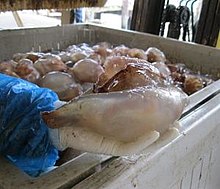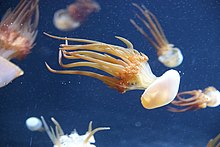Jellyfish as food (original) (raw)
From Wikipedia, the free encyclopedia
Use of jellyfish as a product for human consumption
Raw cannonball jellyfish (known locally as "jellyballs") in the U.S. state of Georgia prior to being dried, preserved and packaged. After processing, the product is sold to a seafood distributor that ships them to Japan, China, the Philippines, and Thailand.
Edible jellyfish prepared with sesame oil and chili sauce
Rhopilema esculentum is a species of edible jellyfish
Some species of jellyfish are suitable for human consumption and are used as a source of food and as an ingredient in various dishes. Edible jellyfish is a seafood that is harvested and consumed in several East and Southeast Asian countries, and in some Asian countries it is considered to be a delicacy. Edible jellyfish is often processed into a dried product. Several types of foods and dishes may be prepared with edible jellyfish, including salads, sushi, noodles, and main courses. Various preparation methods exist.
In China, some species of jellyfish in the Rhizostomeae order caught in coastal areas have been utilized as an aphrodisiac and a source of food and ingredient in Chinese cuisine for over 1,700 years.[1] Cannonball jellyfish (Stomolophus meleagris)[2][3] and jelly blubber (Catostylus mosaicus)[4][5][6] are edible species of jellyfish. When live, the cannonball jellyfish contains toxins that can cause cardiac problems. Rhopilema esculentum[7] and Rhopilema hispidum are edible jellyfish, and are the most common ones consumed in China, Japan and Korea.[2] Additional edible jellyfish species include Aurelia aurita, Crambionella orsini,[8] Chrysaora pacifica, Lobonema smithii, Lobonemoides gracilis and Nomura's jellyfish (Nemopilema nomurai).[2] Desalted ready-to-use jellyfish are low in calories and contain hardly any fat, about 5% protein and 95% water.[9] They do not have much flavor, and may be used to add additional texture and mouthfeel to various dishes.[10] In some areas of Asia, jellyfish is "associated with easing bone and muscle pain."[10]
In 2001, the annual global harvest of edible jellyfish was estimated to be around 321,000 metric tons (316,000 long tons; 354,000 short tons).[1] The most prominent countries involved in edible jellyfish production are Myanmar, China, Indonesia, Korea, Malaysia, the Philippines and Thailand.[2] In China, jellyfish larvae are reared in ponds before being released as juveniles into the sea to grow and mature.[11] In Southeast Asia, edible species of jellyfish may be harvested using various nets such as drift nets, scoop nets, set nets and hand nets, hooks and beach seines.[1] In 2001, the estimated annual catch in Southeast Asia in net weight was at around 169,000 metric tons (166,000 long tons; 186,000 short tons).[1] The amount of jellyfish caught annually in this region can vary significantly, and the fishing season for them is relatively short, at two to four months.[1]
Traditional methods of processing jellyfish into a dried food product can take a considerable amount of time, between 19 and 37 days.[2] A common processing technique is the preservation of jellyfish, which may utilize salt curing to accomplish this, creating a dried finished product.[10][12] Some commercially processed edible jellyfish are purveyed in dried sheets.[12] The process of producing dehydrated jellyfish typically includes the removal of the tentacles prior to drying,[6][13] because the upper dome area of the marine animal is the part typically used for cooking.[10]
Jellyfish deteriorate rapidly at room temperature so processing starts soon after they are caught. The bell is separated from the dangling oral arms and both are washed in seawater before being scraped to remove the gonads and mucus. Dehydration is traditionally undertaken by sprinkling the jellyfish with table salt and alum, draining off the brine and repeating the process.[14] Finally the jellyfish are heaped to drain, turned several times and left to dry. The whole process takes three to six weeks and results in a product with about 65% moisture and 20% salt. The alum reduces the pH and serves to firm the texture while the salt removes water and prevents microbial deterioration. In Malaysia and Thailand, a little sodium bicarbonate, which facilitates dehydration and increases crispness, is added during processing.[9]
Jellyfish is consumed in several East Asian and Southeast Asian countries. In 2001, it was reported that Japan had annually imported between 5,400 and 10,000 tons of edible jellyfish from Indonesia, Malaysia, Myanmar, the Philippines, Singapore, Thailand, and Vietnam.[1] Dehydrated and pickled jellyfish is considered a delicacy in several Asian countries, including China, Korea, Vietnam, and Japan.[4][15] Dehydrated jellyfish can be prepared for eating by soaking it in water for several hours to rehydrate it, and then parboiling, rinsing and slicing it.[13]
Consuming echizen kurage is potentially dangerous if the toxic part is not thoroughly cleaned and cooked.[16]
Jellyfish salad, a popular dish in some areas of Asia, may be prepared using cold marinated jellyfish that is thinly sliced.[17] Some Chinese restaurants such as din tai fung serve jellyfish salad as a part of their meals.[13] Jellyfish sushi is consumed in Japan.[18] In Thailand, a crunchy style of noodle is produced using jellyfish.[18] The Japanese company Tango Jersey Dairy produces a vanilla and jellyfish ice cream,[19][20] prepared using cubes of diced Nomura's jellyfish (Echizen kurage in Japanese) soaked in milk.[20] It has been described as "slightly chewy". In Sarawak, the eastern part of Malaysia, a traditional delicacy by Melanau people also uses raw fresh jellyfish into a salad dish called Umai. [21] [20] Following the 2009 Japanese Nomura's jellyfish bloom, students in Obama, Fukui designed a Nomurao Jellyfish powder to be used to make caramel sweets as part of a NASA-designed food safety management system established in the school.[22]
- Jellyfish dishes

A simple jellyfish salad
Jellyfish with shredded chicken at a restaurant
A jellyfish and roast duck salad
A Korean dish incorporating jellyfish
A jellyfish salad
A close-up view of Cantonese-style jellyfish- List of delicacies
- List of dried foods
- List of types of seafood
- ^ a b c d e f Omori, Makoto; Nakano, Eiji (2001). Jellyfish Fisheries in Southeast Asia. Hydrobiologia. pp. 19–26. ISBN 9789401007221.
- ^ a b c d e Ang, C.Y.W.; Liu, K.; Huang, Y.W. (1999). Asian Foods: Science and Technology. Taylor & Francis. p. 262. ISBN 978-1-56676-736-1.
- ^ Purcell, J.E.; Graham, W.M.; Dumont, H.J. (2012). Jellyfish Blooms: Ecological and Societal Importance: Proceedings of the International Conference on Jellyfish Blooms, held in Gulf Shores, Alabama, 12–14 January 2000. Developments in Hydrobiology. Springer Netherlands. p. 15. ISBN 978-94-010-0722-1.
- ^ a b Fraioli, J.O.; Sato, K. (2008). The Complete Idiot's Guide to Sushi and Sashimi. Alpha. p. 9. ISBN 978-1-59257-782-8.
- ^ Pitt, K.A. (1999). Ecology and Fishery of the Edible Jellyfish Catostylus Mosaicus (Scyphozoa, Rhizostomeae) in New South Wales, Australia. School of Biological Sciences, Faculty of Science, University of Sydney.
- ^ a b Pohl, Otto (May 21, 2002). "New Jellyfish Problem Means Jellyfish Are Not the Only Problem". The New York Times. Retrieved July 11, 2015.
- ^ Gershwin, L.; Earle, S. (2013). Stung!: On Jellyfish Blooms and the Future of the Ocean. EBSCOhost ebooks online. University of Chicago Press. p. 274. ISBN 978-0-226-02024-2.
- ^ Suthers, I.; Rissik, D. (2009). Plankton: A Guide to Their Ecology and Monitoring for Water Quality. CSIRO PUBLISHING. p. 208. ISBN 978-0-643-09943-2.
- ^ a b Y-H. Peggy Hsieh; Fui-Ming Leong; Jack Rudloe (2001). "Jellyfish as food". Hydrobiologia. 451 (1–3): 11–17. doi:10.1023/A:1011875720415. S2CID 20719121.
- ^ a b c d Shanahan, Andrew (January 27, 2006). "Anatomy of a dish: Roast suckling pig with jellyfish, Yang Sing". The Guardian. Retrieved July 11, 2015.
- ^ Pitt, Kylie A.; Purcell, J.E. (2009). Jellyfish Blooms: Causes, Consequences and Recent Advances: Proceedings of the Second International Jellyfish Blooms Symposium, Held at the Gold Coast, Queensland, Australia, 22-27 June, 2007. Springer Science & Business Media. pp. 116–118. ISBN 978-1-4020-9749-2.
- ^ a b So, Y. (2006). Yan-Kit's Classic Chinese Cookbook. Yan Kit's Classic Chinese Coobkook. DK Publishing. p. 48. ISBN 978-0-7566-4053-8.
- ^ a b c Hopkins, J.; Freeman, M. (2014). Strange Foods. EBL-Schweitzer. Tuttle Publishing. p. 105. ISBN 978-1-4629-1676-4.
- ^ Huang, Y. Ao-Wen (1988). "Cannonball Jellyfish (Stomolophus meleagris) as a Food Resource". Journal of Food Science. 53 (2): 341–343. doi:10.1111/j.1365-2621.1988.tb07701.x. ISSN 1750-3841.
- ^ Stephens, L.D.; Calder, D.R. (2006). Seafaring Scientist: Alfred Goldsborough Mayor, Pioneer in Marine Biology. University of South Carolina Press. pp. 94–95. ISBN 978-1-57003-641-5.
- ^ Lee, Samantha (2015-10-09). "The 21 most dangerous foods in the world". Business Insider Singapore. Retrieved 2018-01-18.
- ^ Usborne, Simon (April 9, 2009). "Want to save the planet? Tuck in to some jellyfish and chips, squid sausages and algae burgers..." The Independent. Retrieved July 11, 2015.
- ^ a b "Is jellyfish sushi the future for fish lovers?". Marie Claire. March 5, 2009. Archived from the original on March 4, 2016. Retrieved July 11, 2015.
- ^ "Gigantic jellyfish invade the Sea of Japan". Animal News: Animal Planet. April 26, 2010. Archived from the original on July 12, 2015. Retrieved July 11, 2015.
- ^ a b c Simpson, Aislinn (July 21, 2009). "Japan hit by invasion of giant Nomura's jellyfish". The Telegraph. Retrieved July 11, 2015.
- ^ Zainudin, Aniza. "Umai pembuka selera". Harian Metro.
- ^ "Space caramel made from giant jellyfish". Pink Tentacle. Retrieved 26 February 2016.
- National Geographic (March 13, 1994). "Florida makes pitch for edible jellyfish". The Victoria Advocate. Retrieved July 11, 2015.
- "A Jellyfish Burger". Scientific American. 2009. Retrieved 12 July 2015.
- Edible Jellyfish Pictures & News Photos. Getty Images.




